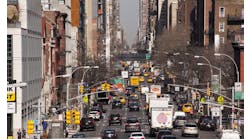By John C. Deerkoski, Contributing Author
What an amazing time to be working on transportation infrastructure projects in the New York Metropolitan area. The region has seen a steady increase in infrastructure investment over the past decade, and it seems this trend will not only continue, but accelerate. Recent projects, such as the new Governor Mario M. Cuomo (a.k.a. the Tappan Zee), Goethals, and Kosciuszko Bridges, greatly improved traffic flow in the region, but additional improvements, like the new Gateway rail tunnel connecting New York City and New Jersey, are needed. Those of us in the engineering and construction industries need to actively advocate for more funding for transportation projects to ensure that this vital work continues.
The N.Y. Metropolitan area is one of the most densely populated regions of the United States and a major economic engine. Maintaining an efficient flow of residents, commuters, and goods is essential to the financial health of the region and the country. Due to the complexity of the entire transportation system and the diversity of uses, increasing capacity necessitates a multi-modal approach and rethinking existing transportation corridors to find more innovative solutions.
Recent trends show that there is strong public support for redesigning urban highways to reconnect neighborhoods, provide more greenways and open spaces, and improve air quality. In addition, efforts to increase the number of dedicated bikeways and the implementation of bicycle sharing programs has been highly successful. Over the past decade, the New York City and New York State Departments of Transportation (NYCDOT, NYSDOT), Metropolitan Transportation Authority (MTA), New York State Thruway Authority (NYSTA), and Port Authority of New York and New Jersey (PANYNJ) have been coordinating their efforts, and have been incorporating these and other concepts into their programs.
Even with a multi-modal transportation plan, increasing capacity has its challenges. The existing transportation network (roadways, bridges, transit/rail systems) is mostly constructed in densely built areas with limited space for expansion. The local agencies responsible for planning, building, operating, and maintaining the existing infrastructure are taking a long view on what large-scale capacity enhancements will be needed in the next 30 to 50 years. Meanwhile, they are maintaining the existing infrastructure and constructing smaller projects that increase efficiency while providing incremental growth to system capacity. Advances in technology, such as open road tolling, have improved traffic flow without significant modifications or expansions. The MTA, NYSTA, and PANYNJ have embraced this technology and the results have exceeded expectations.
Anyone who has experienced traffic congestion in the region’s cities can attest to the need to reduce the number of vehicles on the streets. This is most pronounced in Manhattan and other heavily developed areas, where few opportunities exist to increase travel lanes and bridge capacity to provide more vehicular access. As a result, transportation investments in these areas are primarily centered on enhancing bus/rail transit and bicycle access. Projects such as the MTA’s extension of the No. 7 subway line, East Side Access and Penn Station Access are improving the flow of passengers into and within the city. The long-anticipated Second Avenue subway expansion, for instance, is expected to have a total ridership of 300,000 people, which according to the MTA is equal to that of the entire Philadelphia rail system. Thornton Tomasetti was fortunate to have participated on the Second Avenue subway project, for which we designed some of the complex support of excavation systems, and the East Side Access project, where we performed structural design for some ventilation buildings.
In addition to these high-profile projects, the MTA has been making a number of system upgrades, including improving ADA access and passenger circulation within existing stations. An example of this type of work is the MTA Flushing Main Street Station circulation improvement project, where the addition of new staircases and reorientation of existing ones will help ease congestion at the subway platform and street levels. Thornton Tomasetti is working for contractor ECCO III Enterprises as a subconsultant to LHP Architects, and is providing civil, structural, and support of excavation design for the project.
The local roadway system has seen significant investment by NYSDOT and the MTA to reduce congestion and improve capacity and traffic flow. The NYSDOT has invested nearly $2 billion in improving vehicular access between Kew Gardens and John F. Kennedy International Airport in Queens, and a similar amount on the reconstruction of the Bruckner-Sheridan Interchange in the Bronx. This includes projects to reduce truck traffic on local streets around the busy Hunts Point Market. Meanwhile, MTA Bridges & Tunnels has been improving access from its facilities to the NYSDOT and NYCDOT network with the recent construction of a new ramp from the Robert F. Kennedy Bridge facility to the Harlem River Drive. In addition, it is developing projects that will add capacity and improve accessibility to Randall’s Island.
As these examples show, New York is heading in the right direction, but we need to continue to advocate for funding for all modes of transportation with federal, state, and local elected officials. If we look at the big picture, one where the city’s vast transportation is safer, more reliable, sustainable, and less congested, the potential return on investment is huge.
With renewed commitment to transportation investment and the advent of design-build as an expedited project delivery method, there will be a tremendous amount of additional design and construction that will need to be performed in the next few years. The engineering and construction industries will be ready to meet the challenge. RB
John Deerkoski is a senior principal and Transportation practice co-leader at Thornton Tomasetti.



